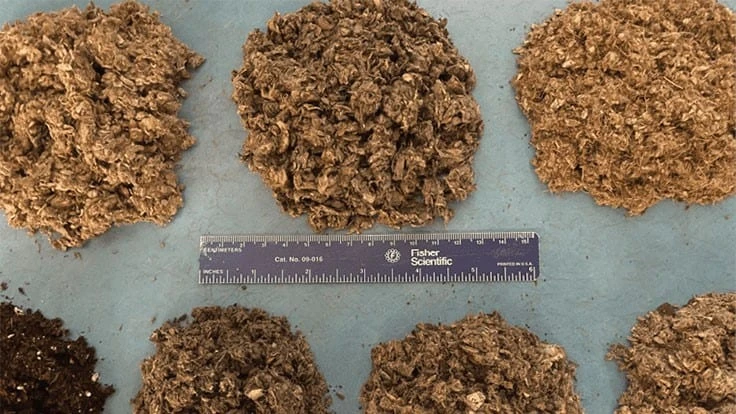

Either proactively or reactively, the need for substrate (growing media) options is always important for growers.
Recent shortages have led to many growers being forced or highly encouraged to turn to “Plan B” in their substrate toolbox to bridge the gap between increased demand and some drastic shortages of common growing media components and products.
Many growers have even had to turn to “Plan C” or beyond to acquire the volumes of substrates needed for their rapidly expanding operations. Aside from supply shortages, other consumers have elected to explore new or alterative substrate options based on sustainability beliefs and goals, desire to use local or regional materials, the opportunity to utilize raw materials they already have access to, or to adopt new substrates that are better crafted to better optimize the crops they are growing in the specific growing systems they are utilizing.
Whatever the reason, the interest and demand for non-traditional substrate materials has never been higher, a trend that will only increase exponentially in the future.
This article will discuss some of the materials that are in higher demand and use today based on any or all of the above-mentioned reasons. It is also very important to note that not all possible substitutions or alternatives are listed here, as there are many that warrant attention and consideration.Lastly, it should be strongly emphasized that there are no “replacements” for any substrate materials, as it is impossible to truly and literally replace something. So, there are no “peat replacements” or “perlite replacements” but instead viable materials that are suitable alternatives or substitutions to certain commonly known (traditional) materials.
Processed bark
While not new or novel in any way, processed bark materials continue to evolve in their usage across many substrate product lines and growing systems (Fig. 1). A material used by growers since the 1960s, bark, particularly aged pine or fir bark, continues to fill the void left behind by peat or coconut (mainly coir) product shortages. Most traditionally used in outdoor ornamental nursery crop production and more recently in soft fruit container production, the use of bark as a an aggregate additive or extender to peat in greenhouse substrates has increased significantly in the past decade. Thanks to advanced and particular processing techniques and handling methods, bark can be processed into a wide range of particle sizes as illustrated in Figure 1. These size fractions can then be combined in any conceivable combination to engineer a substrate with very specific air and water properties, drainage profiles, densities, or structure for long-term container production.
For example, bark can be processed (double processed), fractioned, and reconstituted to have identical air and water porosities has any peat or coir substrate. Couple those abilities with the option of blending other materials with bark, and the options for nursery, greenhouse/floriculture, cannabis, or soft fruit production can be successful, even without traditional peat or coconut coir (excellent materials by the way) if they are unavailable or not desired.

Biochar additives
Interest remains high for biochar products as additives or substitutes in soilless substrates (Fig. 2A-B).
Perhaps still more of a highly specialized or “novelty” component for many growers, others have trialed or adopted biochar products in some of their operations.
First, it is worthy of discussion that “biochar” can in many justified ways be considered a verb and a noun based on the high variability that can (and does often) exist in commercial products based on manufacturing methods and feedstocks. Similar to compost, biochar products can be extremely variable from source to source and even within a single production source over time. The cost of biochar also remains high in many areas and therefore is often not as economical as other materials.
The availability, consistency and cost of biochar products is improving, however, and eventually the price and quality will likely be highly predictable and dependable.
As far as uses, despite some reports, biochar cannot replace peat moss, but it can serve as an adequate substitute for perlite and it can be used as a partial peat or bark substitute or extender if the particle size is suitable/acceptable to the mix it is being added to. The stability that biochar adds to substrates is exceptional (for longer term perennial crops in containers), and most biochars can provide some limited nutrient availability to crops, increased nutrient holding and exchange capacities, and it can also initiate or host beneficial biological/microbial activity in soils and soilless substrates.

Rice hulls
Rice hulls have seen a tremendous boost in sales and utilization across the horticulture industry in recent years. Thoroughly developed in the early 2000’s in large part due to research efforts from Dr. Mike Evans at the University of Arkansas (currently at Virginia Tech), rice hulls have been a trusted and viable commercial substrate component for many years.
Investigated as a substrate aggregate (perlite substitute), rice hulls were also discovered to be a highly effect weed barrier when used as a container mulch on outdoor (nursery) crop production. The extreme shortages in the perlite supply chain since 2020 have renewed the interest and use of this material as an aggregate to peat substrates. Available in small and large compressed bales, parboiled rice hulls are a regionally available (Arkansas and the Mississippi delta), organic by-product with large volumes of supply typically available (Fig. 2C-D).
Pittmoss
No stranger to the growing media arena, Pittmoss is a product line (as well as the name of the company and brand) that has been producing growing media components since about 2015. Originally produced from just recycled newspapers and cardboard, today the Pittmoss product line uses other recycled organic/cellulosic materials as well.
No longer a local Pennsylvania and surrounding states product, Pittmoss now has at least seven products available for both professional and retail/hobby markets (Fig. 3). Best when used as an additive or extender to peat moss, coconut coir, aged bark or perhaps even wood fiber, the inherent physical and chemical properties seem to be suitable and beneficial as a mix component. Perhaps a good option for extending peat and coir supplies for short(er) term crop production.

Processed miscanthus
The outlier of the group, processed miscanthus biomass, is appearing more and more on the alternative substrates radar.
Initially investigated well over a decade ago for its potential use as a component in nursery crop production, miscanthus today is being evaluated heavily again for other potential uses.
The availability of miscanthus biomass mostly comes from the large acreage that was planted 10-15 years ago during the early stages of the biofuel revolution when investors, business folks, and growers were planting thousands of acres proactively in hopes that the biomass market (for biofuel production) would explode and be a huge return on investment. While there is still biomass and biofuel research being conducted today, the volume of unutilized miscanthus in the eastern US is extensive.
Based on new processing technologies and material preconditioning treatments, miscanthus grass can be refined in to very fiberous, water absorbing, and low-density substrate components (Fig. 4). The potential for this fiberous material to be a suitable substrate component for short term crop production is increasing.

Explore the January 2022 Issue
Check out more from this issue and find your next story to read.
Latest from Greenhouse Management
- North Carolina Nursery & Landscape Association announces new executive vice president
- Plant Development Services, Inc. unveils plant varieties debuting in 2025
- Promo kit available to celebrate first National Wave Day on May 3
- Applications now open for American Floral Endowment graduate scholarships
- Endless Summer Hydrangeas celebrates 20 years with community plantings
- Invest in silver
- Garden Center magazine announces dates for 2025 Garden Center Conference & Expo
- USDA launches $2 billion in aid for floriculture growers





